Hedges with blossoms are much more attractive as privacy screens than bare fences and walls. We introduce you to the top 12 hardy flowering hedges for the garden.

When you think of hedges, you often think of the picture accurately in the form of cut, green hedge plants. No wonder, after all, classics like the tree of life (Thuja) or false cypress (Chamaecyparis lawsoniana) one of the most popular hedges to this day. But if you don't feel like the same green hedges, you don't have to do without the privacy screen: Blooming hedges are a great eye-catcher in the garden. In particular, their versatility, with which they present themselves anew from season to season, offers the variety that many gardeners miss in evergreen hedges. In addition, flowering hedges also enrich the biodiversity in the garden. The flowers often grow numerous Beneficial insects while birds like to use the hedges as a retreat. We have put together our twelve favorite hardy hedge plants with flowers in this list for you.
contents
- 1. Bladder spar
- 2. Blood currant
- 3. Box-leaved barberry
- 4. Chinese winter bloom
- 5. Noble lilac
- 6. Common pipe bush
- 7. Kolkwitzie
- 8. Mayflower bush
- 9. rose
- 10. Blackthorn
- 11. Perennial hibiscus
- 12. Weigela
1. Bladder spar
If you don't feel like boring green hedges, you should definitely get the bladder spar (Physocarpus opulifolius) watch. The Diabolo ’bladder spar, for example, is an eye-catcher with its blood-red leaves that appear almost black in the sunlight. From May to June in particular, the flowering hedge forms a dramatic climax when the creamy white flowers open. The red-leaved ‘Diable d’Or’ or the yellow-leaved Dart’s Gold ’variety also impress with their blossoms and foliage color. The bladder spar is particularly popular because of its absolutely easy-care nature: The flowering hedge is not only hardy, but also very robust and, with a height of up to three meters, forms a reliable privacy screen in the Summer.
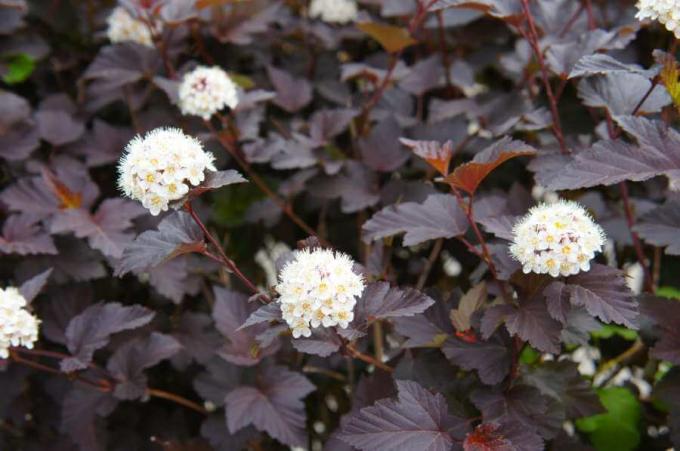
2. Blood currant
Thanks to its robust nature, the blood currant (Ribes sanguineum) especially for a free-growing flowering hedge. So the plant hardly needs any maintenance except for regular watering. In addition, the blood currant is particularly hardy as a flowering hedge. Thanks to its dense branching and a height of up to two meters, the plant is also suitable as a privacy screen. The pretty red flowers of the plant appear from April to May and not only attract everyone's attention, but also magically attract insects. As an ornamental form, the blood currant uses only sparsely edible fruits, which have a very sour taste and are therefore very unpopular with humans. Birds, on the other hand, are happy about the berries and like to use the hedge as a source of food.

3. Box-leaved barberry
It is one of the most famous flowering hedge plants: the box-leaved barberry (Berberis buxifolia ‘Nana’) has become more and more popular recently because it is considered a good and robust substitute for boxwood. The barberry is particularly suitable for smaller hedges, because it is considered to be very hardy and easy to cut. In May, when the evergreen, blooming hedge shows its golden yellow flowers, it even trumps the boxwood: The flowers are real insect magnets that attract beneficial insects of all kinds. The spherical, black and blue berries, on the other hand, are often eaten by birds.
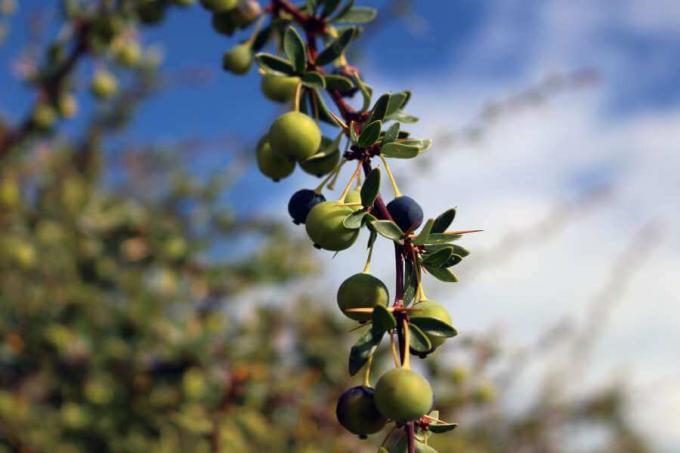
4. Chinese winter bloom
A flowering hedge in winter? In fact, this is not a dream, but rather the one Chinese winter bloom (Chimonanthus praecox). As early as January - in milder winters even before Christmas - the flowering hedge plant shows its full splendor and opens its yellow star blossoms. The exotic plant is not only a glimmer of hope for people in winter: mild curls Temperatures beneficial insects from their roosts, they find a welcome in the Chinese winter bloom Food dispenser. With a height of up to three meters and sparse growth, the winter bloom is particularly suitable for mixed flowering hedges. However, it needs winter protection in the first few years. As soon as the Chinese winter bloom has established itself as a flowering hedge, it will last Temperatures down to -10 ° C stood without problems and therefore applies in most regions of Germany as hardy.
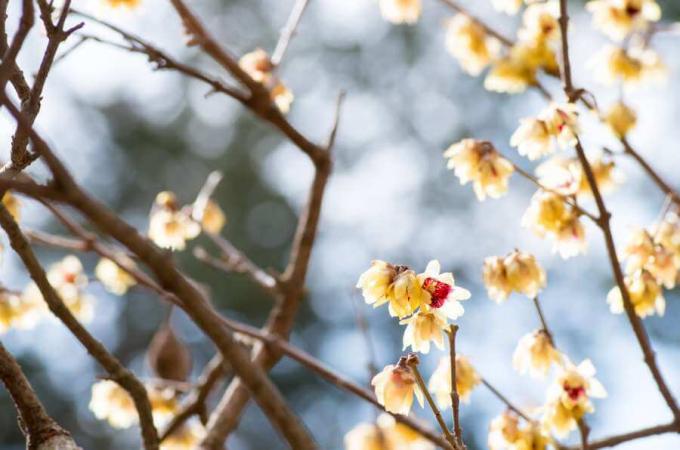
5. Noble lilac
With its intense smell, the noble lilac (Syringa vulgaris) a welcome guest in many gardens who not only flatters the nose. As soon as the shrub shows its blue-violet flowers in May, the plant also turns into a real feast for the eyes. Anyone looking for an easy-care flowering hedge will make the right choice with the uncomplicated and hardy noble lilac.

6. Common pipe bush
A strong scent of jasmine and an impressive abundance of flowers - no wonder that the common pipe bush (Philadelphus coronarius) also bears the name of false jasmine. Especially the intense scent of the white flowers, which show up from May to June, makes the flowering hedge a popular garden dweller. Beneficial insects also love the common pipe bush - it is not one of them for nothing bee-friendly shrubs. As part of a flowering hedge as a privacy screen, the common pipe bush is well suited: it can grow stately in a relatively short time Reach heights of up to four meters and has a special effect with its slightly overhanging growth and matt, deciduous leaves attractive.

7. Kolkwitzie
Between May and June the Kolkwitzie impresses (Kolkwitzia amabilis) with their light pink, slightly shimmering flowers. The romantic sheen of its pastel-colored flowers even gave the flowering hedge the pretty nickname “mother-of-pearl”. But the Kolkwitzia is not only a treat for the eyes - when the hedge is in bloom, it gives off a pleasant smell in the garden, which also attracts numerous beneficial insects. Thanks to their rapid growth, which can be around 30 centimeters per year, and especially theirs robust creatures, the flowering hedge is ideal for being quicker and easier to care for in summer Privacy screen. In winter, on the other hand, it is less suitable as a privacy screen, because the flowering hedge is hardy, but slowly loses its leaves in autumn after a pretty autumn color.
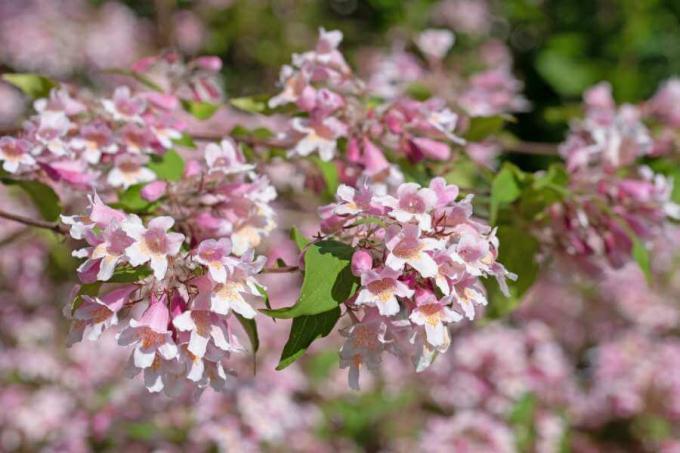
8. Mayflower bush
If you want to talk about flowering hedges, you come to the may flower bush (Deutzia gracilis) not over. As the name suggests, the may flower bush shows a lush pile of star-shaped, small flowers from May to June. During this time, the white flowering hedge fills the garden with a pleasantly sweet scent, which also attracts numerous bees. With a maximum height of one meter and its robust nature, the deciduous plant is particularly suitable for creating a small, blooming hedge.
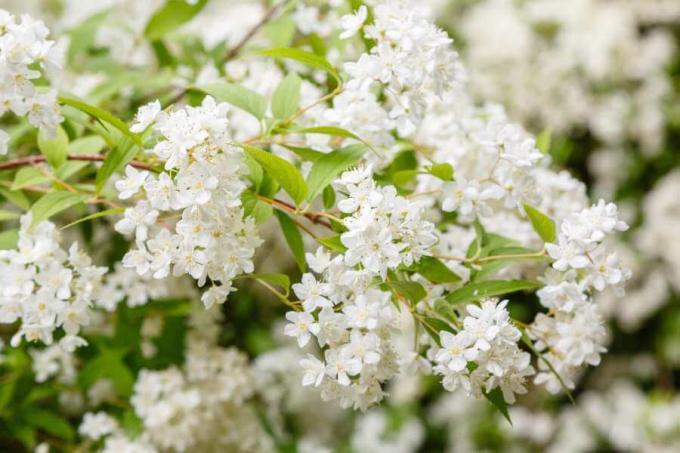
9. rose
Roses (pink) are a must for many people in the garden. Few people know that roses can also be wonderfully integrated as privacy screens in the garden. Indeed, flowering hedges are out Wild roses, such as the potato rose (Rosa rugosa) or the sand rose (Rosa mollis) a great alternative to common hedges. The numerous flowers, the flowering time of which can vary greatly depending on the variety, attract not only people, but also numerous insects. In fact, wild roses offer a good nutritional basis for all kinds of beneficial insects - very much in the In contrast to the common cultivated roses, which are often useless for insects due to their double flowers are. In late summer, the flowering hedge will also delight you with the healthy ones rosehipsthat tastes equally good to humans, but also to many species of birds.
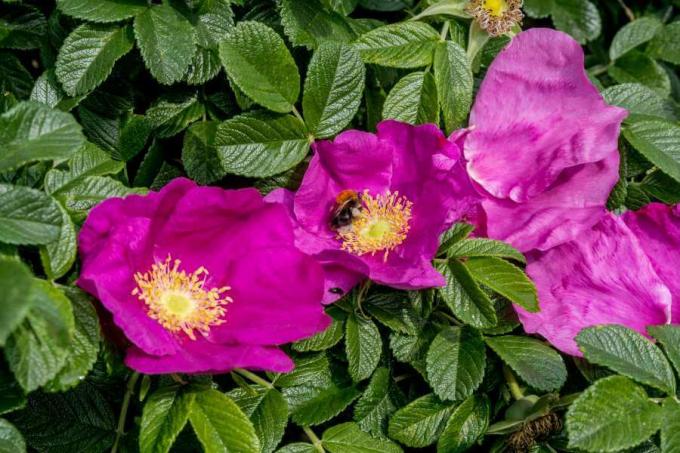
10. Blackthorn
If you not only value a nice privacy screen, but also practical use, you should choose your hedge on the black thorn (Prunus spinosa) not over. the sloeAs the flowering hedge is also called, not only impresses with its numerous flowers from March to April, but is also extremely insect-friendly. In addition, the white flowering hedge gives off a pleasant, sweet smell. From late autumn onwards, edible stone fruits appear on the blackthorn, which can be harvested after the first frost. People particularly like liqueurs or jams made from the tart, aromatic fruits, while birds like to steal the berries straight from the tree. The deciduous blackthorn is particularly popular in near-natural gardens, as it is not only an important nourishment and nutrient for bees Represents a bird protection wood, but thanks to a height of up to 5 meters and a dense growth a reliable privacy screen offers.
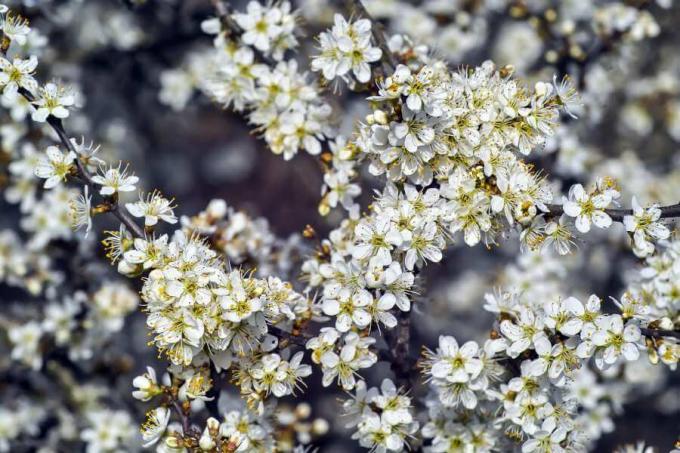
11. Perennial hibiscus
It is a real insider tip among the flowering hedge plants: the perennial hibiscus (Hibiscus moscheutos) impresses with huge, bell-shaped flowers from July to October. The white, pink or red flowering hedge not only attracts people's eyes, but also attracts numerous insects. Thanks to its bushy growth, the evergreen flowering hedge is perfect as a privacy screen for the balcony and garden. In contrast to others Hibiscus varieties it proves to be particularly hardy: an established perennial hibiscus can withstand temperatures of up to -30 ° C. Only young plants need light protection from the weather in winter.

12. Weigela
Hardly any flowering hedge plant is as popular as the weigela (Weigela florida): The indestructible permanent bloomer is considered to be particularly easy to care for and is one of the few hedges that almost completely Year bloom: From the end of April the white to pale pink flowers open and bloom into June tireless. But even in July and even until the first frost, there are always isolated re-blooms. With a height of up to three meters, the weigela is wonderfully suitable as a privacy screen - but you have to Cut weigela, preferably regularly, otherwise it tends to age.

You haven't found the right plant for your garden yet? In our article "Plants as privacy screens: Our top 15 for the garden & balcony“.



